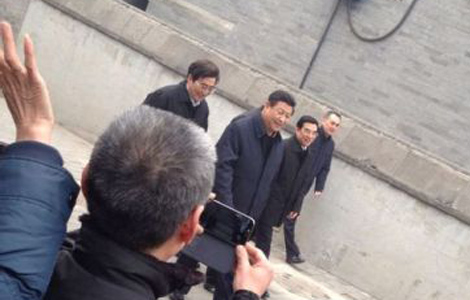Consumer economy isn't happening: economist
Updated: 2014-02-24 10:45
By Michael Barris in New York (China Daily USA)
|
||||||||
More evidence that China remains far from reaching its goal of growing through domestic consumption and reducing reliance on exports came in a new report showing that the nation's manufactured exports in 2013 dwarfed the US's by 83 percent.
The figures, contained in a report by Ernie Preeg, an economist with the Manufacturers Alliance for Productivity and Innovation, a Virginia-based industry think-tank, put China on track to double the US in manufactured exports in three years.
The shift to a consumption-based economy "isn't happening - at least, it didn't happen in 2013," Preeg told China Daily in an interview on Friday. "For 2013, all the talk about shifting away from exports - they were still booming away." In fact, exported manufactured goods in China grew slightly faster than the nation's gross domestic product last year, Preeg said.
Preeg's view echoed other economists who have said China showed little or no progress last year in its plan to rebalance the economy toward consumption.
David Dollar, a former US Treasury Department economic and financial emissary to China, told China Daily in an interview last week that he saw no sign that the rebalancing was gaining traction, as investment accounted for more than half the nation's economic activity last year.
Many economists say embracing consumption and shifting emphasis away from investment and exports would set China's economy on a sustainable course for growth.
The MAPI report said Chinese exports in the information technology sector for 2013 totaled $769 billion - 3.7 times more than the US figure. The China-US gap was widest in export growth - $72 billion for China last year versus $3 billion for the US.
Preeg said an $11 billion fourth-quarter increase in the US deficit with China in manufactured exports translated to a three-month net loss of 40,000 to 100,000 US manufacturing jobs. In the final quarter of 2013, the US trade deficit surged 9 percent as exports rose 3 percent, he said. For the full year, US exports edged up 2 percent. Chinese exports grew 10 percent for the quarter and 8 percent for the full year, according to the economist.
The estimated US job losses suggest that "a broad range of export-oriented growth strategies among major trading partners, with some powerful mercantilist forces in play, pose a continuing threat to US trade competitiveness for manufactures", Preeg said.
The MAPI report showed that among the nine largest high-tech sectors of trade, the US had the largest export lead over China in vehicles. That edge reflected "the highly trade-oriented North American free trade market."
The Chinese lead centered on three information technology sectors - office and data processing equipment, telecommunications and sound recording, and electrical machines and equipment, according to the report.
The report, released Friday, comes after China surprised markets Wednesday by reporting that the value of China's total exports climbed 10.6 percent in January from a year earlier, more than five times market forecasts for a 2 percent rise. An official with the Ministry of Commerce dismissed analysts' claims that that the January figures were inflated by "hot money" - funds transferred suddenly from one country to another to ensure the investor gets the highest short-term interest rates possible. The strong exports were in line with the ministry's expectations, the spokesman, Shen Danyang, told a press conference.
Preeg said the MAPI report's upbeat fourth-quarter numbers seem to indicate that the January bounce was on the way.
Preeg said the 2013 trade figures raise "important questions" about the path ahead in 2014 for trade in manufactures, both for the US and China.
Some questions: "Will US export growth of only 2 percent in 2013, down from 5 percent in 2012, bounce back? And will the surge in the deficit in the fourth quarter continue or reverse course in 2014? As for US policies to strengthen US export competitiveness, little positive change can be expected in 2014 for trade, exchange rate and domestic policies," Pregg said.
"The outcome will therefore depend on whether US companies can work to become more cost competitive, and this will depend in large part on what trading partners, most importantly China, do to stimulate their exports," he added.
For China, the outlook is more complex, Preeg said. If internal growth would fall below 7.5 percent, "would the Chinese government also permit the huge trade surplus in manufactures to experience zero or negative growth, thus accelerating the downward path for GDP?"
Economists expect China's economy to grow 7.4 percent this year - its slowest pace in 14 years.
michaelbarris@chinadailyusa.com
Most Viewed
Editor's Picks

|

|

|

|

|

|
Today's Top News
Beijing protests US post on Tibet
President Xi pops in to Beijing's hutong
Pentagon plans to shrink army
Fight over race in admissions
US ready to aid Ukraine financially
Huawei straps on smartwatch play
Consumer economy 'not' happen
Chinese acrobats meet Ringling Bros
US Weekly

|

|













